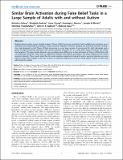Similar Brain Activation during False Belief Tasks in a Large Sample of Adults with and without Autism
Author(s)
Dufour, Nicholas Paul; Redcay, Elizabeth; Young, Liane; Moran, Joseph M.; Triantafyllou, Christina; Gabrieli, John D. E.; Rushton, Penelope Mavros; Saxe, Rebecca R.; ... Show more Show less
DownloadDufour-2013-Similar Brain Activa.pdf (1.979Mb)
PUBLISHER_CC
Publisher with Creative Commons License
Creative Commons Attribution
Terms of use
Metadata
Show full item recordAbstract
Reading about another person’s beliefs engages ‘Theory of Mind’ processes and elicits highly reliable brain activation across individuals and experimental paradigms. Using functional magnetic resonance imaging, we examined activation during a story task designed to elicit Theory of Mind processing in a very large sample of neurotypical (N = 462) individuals, and a group of high-functioning individuals with autism spectrum disorders (N = 31), using both region-of-interest and whole-brain analyses. This large sample allowed us to investigate group differences in brain activation to Theory of Mind tasks with unusually high sensitivity. There were no differences between neurotypical participants and those diagnosed with autism spectrum disorder. These results imply that the social cognitive impairments typical of autism spectrum disorder can occur without measurable changes in the size, location or response magnitude of activity during explicit Theory of Mind tasks administered to adults.
Date issued
2013-09Department
Massachusetts Institute of Technology. Department of Brain and Cognitive Sciences; McGovern Institute for Brain Research at MITJournal
PLoS ONE
Publisher
Public Library of Science
Citation
Dufour, Nicholas, Elizabeth Redcay, Liane Young, Penelope L. Mavros, Joseph M. Moran, Christina Triantafyllou, John D. E. Gabrieli, and Rebecca Saxe. “Similar Brain Activation during False Belief Tasks in a Large Sample of Adults with and without Autism.” Edited by Sam Gilbert. PLoS ONE 8, no. 9 (September 20, 2013): e75468.
Version: Final published version
ISSN
1932-6203